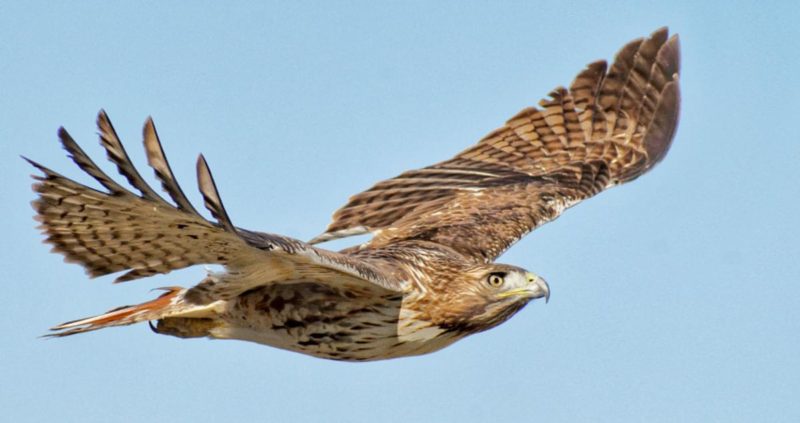Hawks are magnificent birds of prey that can be found all over the world. They are known for their sharp talons, powerful wings, and keen eyesight. With over 270 species of hawks in existence, it’s no wonder they have captured the imagination of bird enthusiasts and nature lovers alike.
In this article, we will explore ten of the most magnificent types of hawks and where you can find them. From the majestic Bald Eagle in North America to the stunning African Harrier-Hawk in sub-Saharan Africa, these birds are truly a sight to behold. Learn about their unique characteristics, habitats, and behaviors as we delve into the world of these awe-inspiring predators.
The Beauty and Magnificence of Hawks
One of the most impressive features of hawks is their keen eyesight, which enables them to spot prey from great distances. This ability is particularly useful for hunting in open areas such as grasslands and deserts, where hawks like the Ferruginous Hawk can be found. With its distinctive rusty-colored plumage and large size, this bird of prey is a sight to behold.
Another striking hawk species is the Red-tailed Hawk, which can be found throughout North America. These birds are easily recognizable by their reddish-brown tails, and they are known for their powerful talons and sharp beaks. The Red-tailed Hawk is a skilled hunter that preys on rodents and small mammals, making it an important predator in many ecosystems.
Other notable hawk species include the Cooper’s Hawk, which has adapted well to urban environments; the Swainson’s Hawk, which migrates long distances between North and South America; and the iconic Bald Eagle, which represents freedom and power in American culture. Each type of hawk has its own unique features that make it a fascinating subject for birdwatchers and nature enthusiasts alike.
The Red-Tailed Hawk:
The Red-Tailed Hawk is a large bird of prey found throughout North America. Its distinctive red tail feathers make it easy to identify, and its broad wingspan allows it to soar effortlessly through the sky. These hawks are highly adaptable and can be found in a variety of habitats, including forests, grasslands, and deserts.
Red-Tailed Hawks are fierce hunters, preying on small mammals such as rodents and rabbits. They also eat birds, reptiles, and even insects. Their powerful talons allow them to grasp their prey tightly while their sharp beak tears into flesh.
Despite being common throughout much of North America, Red-Tailed Hawks face threats from habitat loss and human activity. However, conservation efforts have helped stabilize their populations in some areas. With their impressive size and striking appearance, the Red-Tailed Hawk is truly one of the most magnificent types of hawks out there.
A Classic Sight in North America
The Red-tailed Hawk is a classic sight in North America and can be found all over the continent. They are one of the largest hawks, with a wingspan of up to 56 inches, and are known for their distinctive red tail feathers. These birds primarily hunt small mammals such as rodents, rabbits, and squirrels.
Another iconic hawk species in North America is the Bald Eagle. These majestic birds can be found near large bodies of water such as lakes or rivers where they hunt for fish. They have a white head and tail feathers that contrast against their dark brown body feathers.
Lastly, the Cooper’s Hawk is another common hawk species in North America that can be found in urban areas as well as forests. Known for their agility and speed, these hawks primarily prey on smaller birds such as pigeons or doves. With their striking appearance and impressive hunting abilities, it’s no wonder why these hawks are a classic sight in North America.
The Peregrine Falcon:
The Peregrine Falcon is a magnificent bird of prey that can be found in many parts of the world, including North America, Europe, and Asia. It is known for its incredible speed and agility, which allow it to hunt down other birds in mid-flight. The Peregrine Falcon is also one of the largest species of falcon, with an average wingspan of 3-4 feet.
This bird has adapted well to living in urban environments and can often be seen perched on tall buildings or soaring over city streets. In fact, many cities have set up nesting sites for the Peregrine Falcon in order to encourage their population growth. Despite this success, however, the Peregrine Falcon remains a threatened species due to habitat loss and pollution.
If you are interested in seeing this amazing bird up close, there are many places where you can go to observe them in their natural habitats. Some popular locations include national parks such as Yosemite or Yellowstone, as well as wildlife reserves like the Hawk Mountain Sanctuary in Pennsylvania. Whether you are a seasoned birder or simply an admirer of these majestic creatures, the Peregrine Falcon is sure to leave a lasting impression.
The Fastest Animal on Earth
The Peregrine Falcon, also known as the duck hawk or peregrine, is considered the fastest animal on earth with a diving speed of up to 240 mph. These birds of prey are found worldwide and are known for their exceptional hunting skills. They have sharp talons and beaks that can effectively catch and tear apart their prey.
Another fast-flying hawk is the Gyrfalcon, which is native to the Arctic region. It has been recorded flying at speeds of up to 130 mph while chasing down small birds in mid-air. The Gyrfalcon’s hunting prowess has made it a favorite among falconers, who train these birds for use in hunting expeditions.
In conclusion, the world’s fastest animals are not only remarkable but essential for maintaining balance in various ecosystems. Whether it’s the Peregrine Falcon or Gyrfalcon, these majestic birds of prey demonstrate impressive agility and strength when pursuing their prey. So next time you spot one soaring through the skies above you, take a moment to appreciate their incredible abilities!
The Cooper’s Hawk:
The Cooper’s Hawk is a medium-sized hawk found throughout North America. It has a distinctive gray-blue back, reddish-brown breasts, and a long tail with thick bands. They are known for their impressive agility in flight and hunting skills. These hawks are often found in wooded areas, where they hunt smaller birds and mammals.
One interesting aspect of Cooper’s Hawk is its ability to adapt to urban environments. They have been known to build nests in cities and suburbs, taking advantage of the abundance of prey such as pigeons and squirrels. However, this adaptation has also led to conflicts with humans who view them as a threat to backyard bird feeders.
Despite these conflicts, the Cooper’s Hawk remains an important predator in its ecosystem. As a top predator, it helps maintain balance within its food chain by controlling populations of smaller animals like rodents and small birds. For bird enthusiasts, spotting a Cooper’s Hawk in flight can be an exhilarating experience due to its impressive speed and maneuverability.
A Stealthy Hunter in Urban Areas
One of the most fascinating hawks found in urban areas is the Cooper’s hawk. This stealthy hunter is known for its ability to hunt prey in densely populated areas with ease. With its sharp talons and keen eyesight, it can take down birds and small mammals without being detected by humans.
The Cooper’s hawk is a medium-sized bird of prey that measures around 16-20 inches in length, with a wingspan of up to 35 inches. It has a slate-gray back, rusty-red breast, and white underparts with fine horizontal bars. Its long tail provides excellent maneuverability during flight, making it an agile hunter.
These hawks are commonly found in parks, gardens, and wooded areas within cities and suburbs where they can find prey such as pigeons, doves, squirrels, rabbits, and other small animals. Their impressive hunting skills have earned them the nickname “chicken hawk” due to their tendency to target backyard chickens kept by urban farmers. Despite this reputation, however, Cooper’s hawks are a vital part of urban ecosystems and help control populations of pest species like rodents and feral pigeons.
The Harpy Eagle:
The Harpy Eagle, also known as the American Harpy Eagle, is one of the largest and most powerful eagles in the world. Found in Central and South America, this bird of prey has a wingspan that can reach up to 6 feet and can stand up to 3 feet tall. It is named after the mythical creature harpies, which were half-bird and half-human.
This eagle feeds on a variety of prey such as monkeys, sloths, and birds. Its talons are so strong that it can easily crush the skulls of its prey with just one swift grab. Unfortunately, due to deforestation and habitat loss in its range of countries, the Harpy Eagle is classified as Near Threatened by the International Union for Conservation of Nature (IUCN).
Despite being a rare sight in the wild due to their dwindling populations, there are efforts being made to conserve these majestic birds through breeding programs and protected areas. Seeing these magnificent creatures soaring high above treetops is truly a sight to behold for any nature lover who appreciates some of Earth’s most beautiful wildlife treasures.
A Majestic Bird of Prey in South America
One of the most impressive birds of prey in South America is the Harpy Eagle, known for its striking appearance and powerful hunting abilities. These majestic birds can be found in dense tropical rainforests, stretching from Mexico to Brazil. The Harpy Eagle is one of the largest species of eagle in the world, with a wingspan that can reach up to 7 feet.
Despite their intimidating size, these eagles are rarely seen by humans due to their elusive nature and preference for remote areas. They are skilled hunters and feed on a variety of prey including sloths, monkeys, and large birds such as macaws. Unfortunately, habitat destruction has led to a decline in Harpy Eagle populations across South America.
Efforts are being made to protect these beautiful creatures through conservation efforts and education programs aimed at raising awareness about their importance in maintaining a healthy ecosystem. With continued support and dedication towards preserving their natural habitats, we can ensure that future generations will have the opportunity to witness the majesty of these incredible birds firsthand.
The Northern Goshawk:
The Northern Goshawk is a powerful bird of prey found in the boreal forests of North America, Europe, and Asia. It has a broad wingspan and long tail that help it maneuver through dense woodland areas while hunting small mammals, birds, and reptiles. These hawks are known for their aggressive behavior and impressive hunting skills.
One unique characteristic of the Northern Goshawk is its ability to hunt multiple prey at once. They will often use their sharp talons to kill one animal while using their beak to capture another simultaneously. Due to their fierce nature, they are not commonly kept in captivity or used in falconry.
Despite being skilled hunters, Northern Goshawks face threats from habitat destruction and hunting for sport. Conservation efforts have been put in place to protect these magnificent birds and ensure their survival for future generations to enjoy.
A Winter Visitor to Forested Areas
The winter season is a great time for birdwatching as it brings in a variety of migratory birds to forested areas. One such visitor is the Northern Goshawk, a powerful and agile hawk that can be found in the northern parts of North America, Europe, and Asia. With its striking grey plumage and piercing yellow eyes, this bird of prey is a sight to behold.
In forested areas, the Northern Goshawk can often be seen perched on tree branches or soaring through the skies in search of prey. They are known for their ability to hunt large mammals such as hares and squirrels, making them an important predator in these ecosystems. Despite being skilled hunters, they face threats from habitat loss and hunting by humans.
As a winter visitor to forested areas, the Northern Goshawk adds diversity to local bird populations. Their presence also serves as an indicator of healthy forest ecosystems and highlights the importance of conservation efforts toward protecting these habitats for wildlife.
Other Types of Hawks:
Aside from the ten magnificent types of hawks mentioned earlier, there are still more species of hawks that are worth exploring. One interesting type is the Ferruginous Hawk, which is known for its size and wingspan. These hawks can be found in North America, particularly in grasslands and deserts.
Another type of hawk that stands out is the Rough-legged Hawk. This bird of prey has a unique appearance with feathered legs and feet that provide insulation against cold temperatures. It primarily breeds in the Arctic tundra but can also be seen during winter migration in open fields and grasslands.
Lastly, there’s the Red-shouldered Hawk known for its distinctive call and striking reddish-brown feathers on its shoulders. They inhabit forests near water sources across eastern North America. The Red-shouldered Hawks play an important role as a top predator within their ecosystem by controlling populations of small mammals, reptiles, amphibians, and insects.
Overall, these other types of hawks display different physical characteristics, habits, and habitats which makes them interesting to learn about for bird enthusiasts and wildlife enthusiasts alike.
A Variety of Stunning Raptor Species
One of the most striking raptor species is the Red-tailed Hawk, which can be found throughout North America. These birds of prey have distinctive red tails and are known for their shrill calls. Another stunning hawk species is the Ferruginous Hawk, which can be found in the western parts of North America. These hawks have beautiful rust-colored feathers and are one of the largest hawk species.
Another impressive raptor species is the Bald Eagle, which is commonly associated with patriotism in the United States. These majestic birds have white heads and tails with dark brown bodies and are often seen near bodies of water where they hunt fish. In addition to hawks and eagles, there are also various types of falcons such as Peregrine Falcons and Gyrfalcons that are known for their incredible speed and agility during flight.
Overall, there is a wide variety of stunning raptor species to observe in different regions around the world. Whether it’s watching a Red-tailed Hawk soar through a clear blue sky or spotting a Bald Eagle perched on a tree branch overlooking a river, these magnificent creatures never cease to amaze us with their beauty and power.
Where to Find Them:
- Red-tailed Hawk: This hawk can be found all across North America, from Canada to Mexico. They are often seen perched on telephone poles or soaring in wide circles above open fields.
- Cooper’s Hawk: These birds can be found throughout much of the United States and southern Canada, typically in wooded areas with dense cover. They are known for their stealthy hunting tactics and are often seen darting through trees in pursuit of prey.
- Sharp-shinned Hawk: Similar to Cooper’s hawk in appearance and behavior, this species is smaller and more agile. They can be found throughout much of North America, particularly in forested areas.
- Northern Harrier: This hawk is usually found in open country such as marshes or grasslands across North America, including parts of Central and South America during migration.
- Bald Eagle: One of the most iconic birds in North America, bald eagles can be found throughout the continent near large bodies of water such as lakes or rivers.
- Golden Eagle: These majestic birds can be found throughout western North America, from Alaska down to Mexico.
- Swainson’s Hawk: A migratory species that breeds primarily on the western Great Plains but winters in South America.
- Rough-legged Hawk: During the breeding season they tend to stick to remote Arctic tundra but migrate southward during winter along with other raptors like bald eagles and red-tailed hawks
Tips for Spotting These Amazing Birds
- Red-tailed Hawk: Look for a large hawk with a reddish-brown tail and dark belly. These birds are found throughout North America, often perching on trees along highways or soaring over open fields.
- Cooper’s Hawk: Keep an eye out for a medium-sized hawk with a blue-gray back and barred chest. These birds are common in urban areas, where they hunt small birds at bird feeders and in parks.
- Sharp-shinned Hawk: Spot this small hawk by its short wings and long tail, which it uses to maneuver through dense forests. Look for them perched on branches or darting through the trees in search of prey.
- Northern Harrier: Identify this unique bird by its owl-like face, white rump patch, and low-flying hunting style over marshes and grasslands. They have a distinct V-shaped wing posture while flying.
- Bald Eagle: Spot the iconic national symbol of the United States by their unmistakable white head, brown body, yellow beak, and powerful talons – typically found near rivers or lakes in North America.
- Golden Eagle: Watch for the largest bird of prey in North America with their distinctive golden-brown plumage that shines brightly during flight – often seen soaring high above mountainsides across western regions.
Conclusion: Appreciating the Diversity and Power of Hawks
In conclusion, appreciating the diversity and power of hawks can lead us to appreciate the natural world even more. Hawks are not just powerful hunters but also important indicators of a healthy ecosystem. With their extraordinary eyesight and aerial skills, they play an essential role in maintaining a balance in nature by controlling populations of prey animals.
Each type of hawk has its unique characteristics and habitat preferences, making them fascinating creatures to observe. From the fierce Peregrine Falcon that can reach speeds up to 240 mph during a dive to the majestic Red-tailed Hawk that is commonly found in open fields and deserts, each hawk species has something special to offer.
By learning about these magnificent birds and their habitats, we can better understand how they fit into our ecosystems. We should appreciate their importance and take necessary steps towards preserving their habitats for future generations so that we may continue to enjoy the beauty and diversity of these amazing creatures.
Read Also…. top-10-facts-about-emperor-penguins













